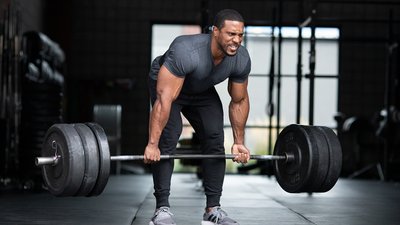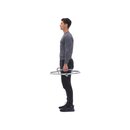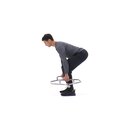Chronic lower back pain is one of the most dreaded things a lifter can deal with. I speak from firsthand experience. I've had my ups and downs in the lumbar region, and it's forced me to learn about the lower back and the hacks that ensure its ongoing safety and good health.
I've also written articles like this before, but the following list of secrets is as in-the-trenches as it gets. I'm not talking about dealing with an injury. I'm talking about day-to-day life, when you're already feeling good.
These are my rules for staying good once you feel good.
1. Go to Bed!
If you're in the habit of short sleeps, only getting 5-6 hours per night regularly, you can say goodbye to long-term back health (and the health of any muscle or joint, for that matter). By truncating your recovery time, you're shooting yourself in the foot. And it's that much worse if you're a die-hard lover of the big compound movements that require a lot of spinal loading, like squats, deadlifts, and overhead presses.
For your body to respect you, you have to respect it. I know that sounds a little Zen, but there's some truth to it. Getting to bed at a decent hour, having a good night's sleep, and waking up at least 7 hours after you doze off will make a world of difference as far as how your body feels, and that includes your injury-prone back. If you've been seeking other patch-job remedies, mobility drills, stretches, treatments, and exercises to bolster your spine without looking at your nightly rest and recovery schedule, I recommend putting it all on the back burner and starting there.

2. Stop Lifting Heavy So Early
This little-known point can make all the difference. People fail to recognize that the time of day they train matters.
Trying to lift relatively heavy weights soon after waking up is not doing your back health any favors. You need to give your body time to get moving and upright, and your disks time to dehydrate. While you're sleeping, they tend to fill with fluids—one reason people will say you're at your "tallest" first thing in the morning.
How well would my 7 a.m. executive clients perform if they trained with me at 11 a.m. or 2 in the afternoon? Personally, I despise lifting heavy in the early morning. I've never had a good feeling after doing it, at least where my spine is concerned. If you've got the flexibility in your morning schedule, try lifting 3-4 hours after you wake up. For example, I love training between 10 a.m. and noon, but I typically wake up at 5:45.
If you're stuck with training at 7 a.m., before work, try waking up earlier, at 5 a.m., not 6:35. Just hit the sack earlier the night before a workout to make up some of the difference. It sucks, but it could be a major factor in your back health.

3. Don't Get Stiff While You're Doing Nothing
Having a bad back is like getting a new puppy. You have a new set of responsibilities, whether you like it or not—that is, if you want a better outcome.
Taking even 5 minutes once or twice per day can be a game-changer for your back. There are mobility drills and stretches that have your name on them. These are movements you need to be doing not only in the gym but, even more importantly, when you're not in the gym. It's easy for your back to feel good during a workout, when your muscles are pumping, your body is sweating, your joints are lubricated, and you're generally warmed up; however, it's not always as easy to get that feeling when you're cold and you've had a day off from the gym.
You need to do unloaded drills to help your cause. I like doing some when I wake up.
Deep Squat
It doesn't matter what your lower back looks like when you do this. I encourage a long, deep squat hold using any form available that will give the lumbar spine a static stretch and get the quads and knees through their full range of motion first thing in the morning. It's okay if your back rounds. In some cases, that may be even better. There are few exercises in the gym that place the lumbar spine into actual flexion or allow the spine extensors to enter a stretch. A deep squat should feel pretty good.
To take things up a notch, add some upper-body mobility to the squat by way of an overhead reach and twist.
Foam Roller Thoracic Extensions
Understanding the relationship between your thoracic spine and lumbar spine can be a lower-back saver. It's of prime importance to maintain a neutral spine while your T-spine takes on the most extension. Often, the T-spine isn't up to the task and relies on the lumber to overarch and make up the difference. That can cause plenty of compression on the lumbar vertebrae and lead to constant discomfort. This drill teaches the T-spine to extend while using a tactile cue—the roller—as an axis point for the back to wrap around. I like it better than most thoracic extension drills, since the others don't include an outside object to cue the lifter or use gravity to help achieve the position.
Lying Thoracic Rotation
The rotation of the T-spine is just as important as its extension. As a bonus, this move will help stretch the lats, which attach to the lumbar region. If you can't make your shoulder and hand touch the ground on each twist, you have work to do. Lying on one side, place a medicine ball or roller under your top knee in order to maintain a point of reference and make sure you don't cheat your range of motion. Just be sure to maintain solid contact on it with your knee.
4. Choose Your Exercises Wisely
Nobody's holding a gun to your head, saying you have to do barbell squats and deadlifts every week. Plus, if you have a history of injury and you're a recreational trainee, you don't need to be a hero. It's time to break the stigma attached to reducing barbell work. Strength and conditioning coaches, who don't realize the gravity of their words, have encouraged that kind of thinking, but there are many pain-free ways to challenge your body and train all your target muscle groups that don't involve traditional squats and deadlifts.
The deadlift is a supremely important exercise, but it won't solve the problems of someone who already has chronic back issues from doing deadlifts or similar moves. Chances are, a closer look at your exercise choices may be a better answer.
How you group the exercises together is equally important to your health in the gym. It's not a smart idea to load up on compressive movements with no break in a single workout. A total-body workout that involves overhead presses, bent-over rows, squats, and Romanian deadlifts may sound like a solid challenge, but it will surely wreak havoc on your disks, especially if you have a grim history of back issues.
Instead, break things up by pairing a compression movement with one that decompresses the spine; for example, a dip, pull-up, hanging leg raise, or pull-down can give your back the break it needs to prolong its health and avoid aggravation.
Here are a couple idea of what a sample compression/decompression workout could look like in action:

BodyFit
$6.99/month- 2,500+ expert-created single workouts
- 3,500+ how-to exercise videos
- Detailed workout instruction
- Step-by-step workout tips
- Training at gym or at home
- Access to Workout Plans
- Access to Bodyfit App
- Store Discounts
Already have a Bodybuilding.com account with BodyFit? Sign In

What comes with BodyFit?

- Instructional Videos
Don't risk doing a workout improperly! Avoid injury and keep your form in check with in-depth instructional videos.

- How-to Images
View our enormous library of workout photos and see exactly how each exercise should be done before you give it a shot.

- Step-by-Step Instructions
Quickly read through our step-by-step directions to ensure you're doing each workout correctly the first time, every time.

BodyFit
$6.99/month- 2,500+ expert-created single workouts
- 3,500+ how-to exercise videos
- Detailed workout instruction
- Step-by-step workout tips
- Training at gym or at home
- Access to Workout Plans
- Access to Bodyfit App
- Store Discounts
Already have a Bodybuilding.com account with BodyFit? Sign In

What comes with BodyFit?

- Instructional Videos
Don't risk doing a workout improperly! Avoid injury and keep your form in check with in-depth instructional videos.

- How-to Images
View our enormous library of workout photos and see exactly how each exercise should be done before you give it a shot.

- Step-by-Step Instructions
Quickly read through our step-by-step directions to ensure you're doing each workout correctly the first time, every time.
Want to lift big and be pain free while you do it? Learn the right way to warm up for your most important upper-and lower-body sessions in Unstoppable: The Ultimate Guide to Training Through Injury, hosted by John Rusin, DPT, only in Bodybuilding.com BodyFit Elite.






